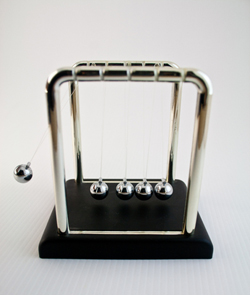
Your body continually tries to return to a "normal" state
Have you ever shivered on a cold day? Felt a little light-headed when you stood up too fast? I’m sure you’ve broken a sweat while doing your PACE exercises, right?
In all these situations, what you’re feeling is your body trying to return itself to a “normal” state. In medical terms, we call it homeostasis — a fancy way of saying that your body is reacting to its environment and trying to get back within its natural chemical, hormonal and temperature ranges.
For example, when your energy levels are low, the conventional wisdom would tell you that your hunger hormones (like leptin and insulin) signal your body to “eat more, expend less.” And when you’ve eaten enough, your hormones should tell you that you’ve had enough.
Either way, your body goes back to a balanced state, and you have homeostasis.
In other words, eating enough should blunt your appetite. If you gain weight, homeostasis should regulate your hunger, physical activity and energy output so that your body goes back to a natural weight relative to your build.
But there’s a problem with the conventional wisdom … in the real world, it doesn’t work that way.
We do eat too much. We have obesity. You can get fat.
Shouldn’t this be impossible? How can every other system in your body be regulated by homeostasis except your weight?
The answer is all around us, even though we don’t notice it most of the time … it’s right there in the food we eat.
That’s because the typical American diet is filled with processed foods, sugars, starches, hormone- and pesticide-laden meats and dangerous preservatives. These foods lack the nutrition your body needs.
And when your body lacks nutrients, it will tell you you’re still hungry. You’ll crave carbs that spike your blood sugar and trigger the hormone insulin to bring your blood sugar down. But when insulin drops your blood sugar too low, you crave even more carbs. And this vicious cycle eventually leads to insulin resistance.
That’s when your body no longer responds well to insulin, so you need to make even more insulin. Before you know it, you’re on insulin overload, which leads to diabetes, but also to weight gain.
Leptin is another hunger hormone produced by your fat cells. It’s the primary hormone that tells your brain to stop eating and storing fat. And that’s a good thing when your leptin levels are normal.
But when you gain weight, your leptin levels are high because you have more fat cells producing it. And when your body has too much leptin, you become” leptin resistant.”
Your brain stops listening to the message that you’ve had enough to eat.
Insulin and leptin resistance both lead to “hormonal hunger” and it’s what the modern world has done to you. The processed foods, grains and starches that you’ve been sold over the last 50 years have changed your body so that it overrides homeostasis and keeps on eating.
The good news is, you can reverse the effects of years of conventional food and nutrition advice which has led to hormonal hunger. You can return your body, and your hormones, to a “normal” state and never have to worry about getting fat if you follow these simple steps:
Don’t listen to conventional wisdom.
Conventional doctors will tell you the key to fat loss is cutting back on calories. But it’s not about the quantity of calories you eat. It’s all about the quality of calories.
The best thing to do is to eat meals based on protein … as many different kinds of protein as you can get. The reason is that it’s not just any calories that signal your body to stop eating. It’s protein.
Getting enough protein tells your body that times are good, and flips your metabolic switch from “store fat” to “melt fat.” Then your body will use the calories as essential fuel to function at its best.
Eat the right fats.
Don’t cut back on fat, either … Instead, eat the right fats like omega-3s. Your body uses them to absorb vitamins and nutrients.
Practice short-duration, high-intensity, progressively challenging workouts.
Exercise is one of the best ways to melt fat and lower your leptin levels.1 But the key to lasting fat loss is to teach your body to melt fat after you exercise — not while you exercise. Conventional trainers try to get you to work out in the “fat-melting zone.” The problem is that it teaches your body to store fat so you can use it for energy while you’re exercising. That’s the opposite of what you want to do.
That’s why with my PACE program I show you how to exercise the way your body was designed to move. That way, you can melt fat after your workout, which teaches your body to store energy in your muscles, instead of as fat around your midsection or rear end. If you want specific workouts, resources and information about creating your own PACE workout, just click here…
Take a multivitamin.
Unless you’re the rare exception, you’re probably not getting the nutrition you need from food. Choose a brand you trust, with natural forms of the nutrients, so you can actually absorb them and they’re available for your body to use.
Eat low-glycemic-index foods.
High-glycemic-index foods, which are usually the processed ones, are loaded with sugars, starches and grains and cause hormonal hunger. But low-glycemic-index foods like nuts, leafy green veggies, meats and fruit do just the opposite. Eat foods low on the glycemic index, and you’ll curb your appetite and shed fat in no time.
The best way to do this is with nutrient-dense foods instead of empty-calorie snacks. These foods provide the most nutrients — vitamins, minerals, fatty acids and fiber — without adding to your waistline or spiking your blood sugar or leptin levels. It’s probably no surprise that the best nutrient-dense foods are all-natural: seeds, nuts, wild-caught salmon, grass-fed beef, free-range poultry, eggs, berries and fruits, and vegetables.
Avoid high-fructose corn syrup.
It’s been found to cause leptin resistance.2 One more reason to stay away from processed foods or anything packed in a box, can or plastic container (even if it’s labeled organic).
Don’t skip meals.
It’ll only put your body in starvation mode and make you binge on carbs that mess with your blood sugar and hunger hormones. Eat three balanced meals a day, especially breakfast, and snack on those nutrient-dense foods in between.
Most Popular:
 Little-known Enzymes Wipe Out Pain Fast
Little-known Enzymes Wipe Out Pain Fast
References
1. Reseland, Janne E. “Effect of long-term changes in diet and exercise on plasma leptin concentrations,”American Journal of Clinical Nutrition Feb. 2001;73(2): 240-245
2. Shapiro, A., Mu, W., Roncal, C., et al, “Fructose-induced leptin resistance exacerbates weight gain in response to subsequent high-fat feeding,” Am. J. Physiol. Regul. Integr. Comp. Physiol. Nov. 2008; 295 (5)

